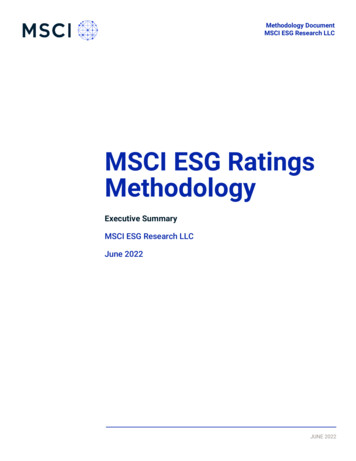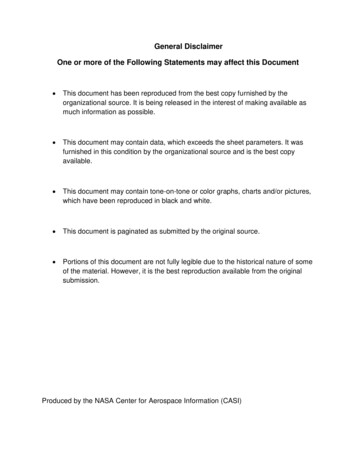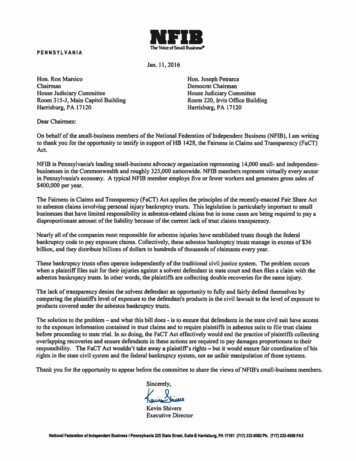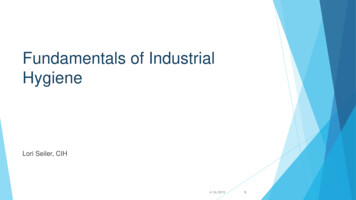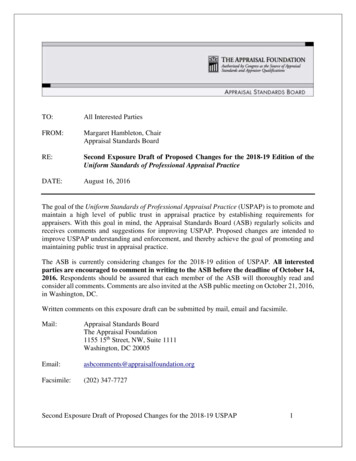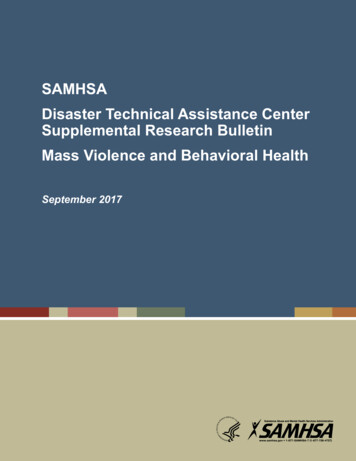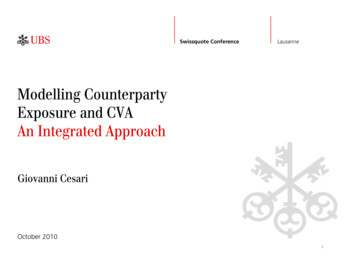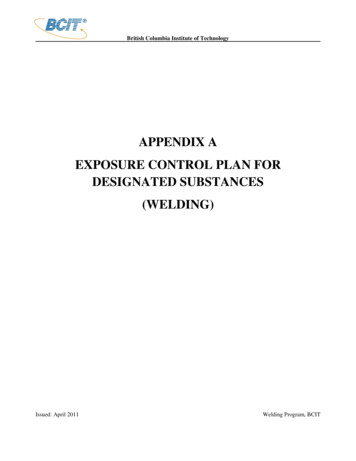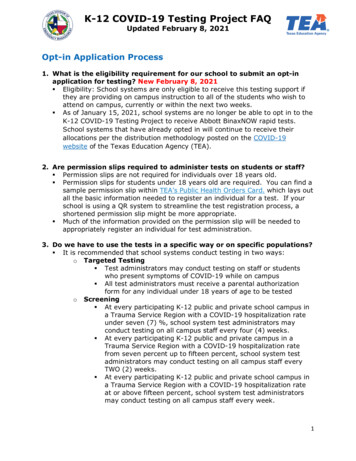
Transcription
U.S. Department of JusticeFederal Bureau of PrisonsPROGRAM STATEMENTOPI:HSD/OEHNUMBER: 6130.01DATE:September 23, 2016Management of Staff Exposureto Bloodborne Pathogens/s/Approved: Thomas R. KaneActing Director, Federal Bureau of Prisons1. PURPOSE AND SCOPEEach institution must establish a plan for management of employee exposures to bloodbornepathogens (BBP) using the following general guidance and the clinical information provided inthe BOP Clinical Practice Guidelines Medical Management of Exposures. The institutionspecific plans for employee post-exposure management should be incorporated into the facility’sBBP Exposure Control Plan, which will be available for all staff.a. Program Objectives. Expected results of this program are: Exposure incidents will be reported promptly. Circumstances surrounding exposure incidents will be evaluated. Institutions will establish relationships with local health care facilities for evaluations andfollow-up care. All staff will be aware of the institution’s BBP Exposure Control Plan and the PEPlineresource.b. Institution Supplement. None required. Should local facilities make any changes outsidethe required changes in the national policy or establish any additional local procedures toimplement the national policy, the local Union may invoke to negotiate procedures orappropriate arrangements.
2. GENERAL PROCEDURESExposed employees must report all exposures to their immediate supervisor or manager assoon as possible and will be relieved immediately. Prompt reporting of exposure incidentspermits timely medical evaluation and follow-up. If evaluation of the circumstances indicatespost-exposure treatment, the exposed employee will benefit from the prompt initiation oftreatment. In addition, timely reporting enables the BOP to more effectively evaluate thecircumstances surrounding the exposure incident to determine preventive measures. All postexposure management (including all laboratory testing and prescribing of medication) for BOPemployees who sustain a BBP exposure will be provided by an outside Health Care Providerexcept for the initial assessment of the exposure and, if indicated, provision of one dose of HIVPEP.Each institution must make an effort to establish a relationship with nearby healthcare facilities(emergency room or urgent care center), where licensed health care providers (HCPs) arefamiliar with Occupational Safety and Health Administration (OSHA) standards for BBP, aswell as Centers for Disease Control (CDC) guidelines for post-exposure prophylaxis for HIV,Hepatitis B, and Hepatitis C and are capable of providing recommended post-exposure followup. Employees can then be referred to these facilities for medical evaluation and follow-up care,including baseline and follow-up labs, with the understanding that each affected employee canseek medical attention at a place of his/her choice. The goal is to obtain PEP within 2 hours ifclinically indicated.In instances where an exposure to blood or other potentially infectious material occurs while atwork, any costs for evaluation, follow-up, and prophylaxis (when medically indicated, asrecommended by the CDC) that are not borne by OWCP are paid by the BOP at no cost to theemployee, in accordance with 29 CFR 1910.30f(1)(ii)(A).3. EVALUATION STEPS (TO BE FOLLOWED IN SUCCESSION IMMEDIATELY)a. The injury site is given immediate care.(1) Needle stick and sharps injuries: The area is allowed to bleed freely for 30 seconds.The area is washed with soap and water or scrub solution.Pressure is applied to stop the bleeding, and a bandage applied if necessary.The exposed employee’s supervisor or manager is notified, along with the CD or physicianon call.P6130.019/23/20162
(2) Eye, nose, and mouth contact: The affected area is flushed with water for 2 minutes. Mouth contamination: spit out any fluid, rinse with fluid, and spit out again. The exposed employee’s supervisor or manager is notified, along with the CD or physicianon call.b. The exposure incident is assessed using BP-A1050, Bloodborne Pathogen ExposureAssessment & Referral Form.PEPline (888-448-4911) should be called for expert physician consultation in assessing theinfectious disease risks associated with the exposure, as well as for recommendations for followup. All efforts should be made to have the employee participate in the call to PEPline.The results of the PEPline consultation are recorded on BP-A1050, Bloodborne PathogenExposure Assessment & Referral Form. The exposed employee is given a copy of the form andinstructed to share the information with the outside licensed HCP who will be providing postexposure management.When the source of a potential BBP exposure is known, that person is tested as follows, but notlimited to (unless he/she has a prior positive result): HIV testing (rapid testing preferred). Hepatitis B (HBsAg and HbeAg when appropriate). Hepatitis C (Anti-HCV).The above test results for the “exposure source” (without personal identifiers) are recorded on theBP-A1050, Bloodborne Pathogen Exposure Assessment & Referral Form, so that the exposedemployee can share this information with the outside licensed HCP.A copy of the BP-A1050 is shared with the Environmental & Safety Compliance Department(ESCD) for inclusion in the OSHA 300 log.c. PEPline Advice and Post Exposure Evaluation/Prophylaxis.In the interests of time, each institution must make an effort to establish a relationship withnearby healthcare facilities (emergency room or urgent care center), where licensed health careproviders (HCPs) are familiar with OSHA standards for BBP, as well as CDC guidelines forpost-exposure prophylaxis for HIV, Hepatitis B, and Hepatitis C.P6130.019/23/20163
(1) If PEPline advises Post Exposure Evaluation/Prophylaxis (PEP).If PEPline recommends HIV PEP, then provisions will be made for the BOP facility to provideone dose of HIV PEP to an exposed employee, within two hours of exposure, in accordance withPEPline recommendations (and after the BP-A1050, Bloodborne Pathogen Exposure Assessment& Referral Form, is completed). The single dose of HIV PEP can be deferred only if theinstitution has an established written agreement with a local emergency medical facility or urgentcare center that ensures provision of HIV PEP within 2 hours of exposure. Under extenuatingcircumstances (i.e., on weekends and holidays), institutions may provide additional doses (up to3 days on a case-by-case basis) of HIV PEP to the exposed staff member, if the exposed staffmember is unable to acquire or fill his/her prescription issued by an outside Health Care Provider(HCP).The employee is relieved from his/her shift and directed to a local emergency medical facility orurgent care center immediately, where licensed HCPs are familiar with BBP standards,experienced in the application of CDC post-exposure prophylaxis, and available for medicalevaluation and follow-up care, including baseline and follow-up labs.(2) If PEPline does not recommend HIV PEP after a percutaneous injury from an unknownsource; i.e., a sharp object that penetrates the skin and is potentially contaminated withblood or other potentially infectious bodily fluids and the source is unknown (e.g., withtattooing equipment or a blood-contaminated shank).If an employee has incurred a percutaneous exposure to blood or other potentially infectiousbodily fluids from an unknown source and PEPLine does not recommend PEP, then BOP willoffer emergent PEP medications to the employee and will pay for the entire PEP regimen if anoutside healthcare provider provides the said prescription.The employee is relieved from his/her shift and directed to a local emergency medical facility orurgent care center immediately where licensed HCPs are familiar with BBP standards,experienced in the application of CDC post-exposure prophylaxis, and available for medicalevaluation and follow-up care, including baseline and follow-up labs.(3) If PEPline does not recommend PEP and there is not a percutane
source; i.e., a sharp object that penetrates the skin and is potentially contaminated with blood or other potentially infectious bodily fluids and the source is unknown (e.g., with tattooing equipment or a blood-contaminated shank). If an employee has incurred a percutaneous exposure to blood or other potentially infectious
